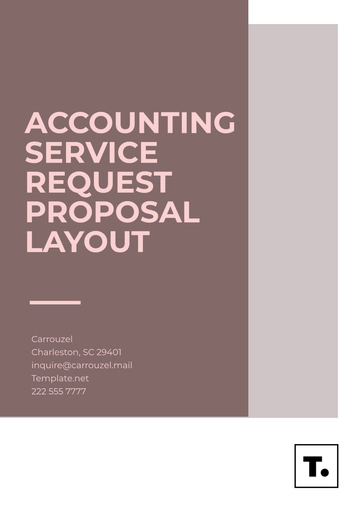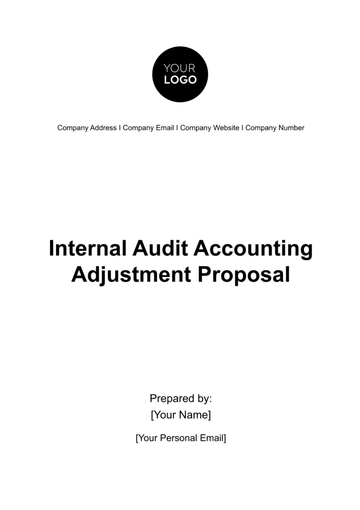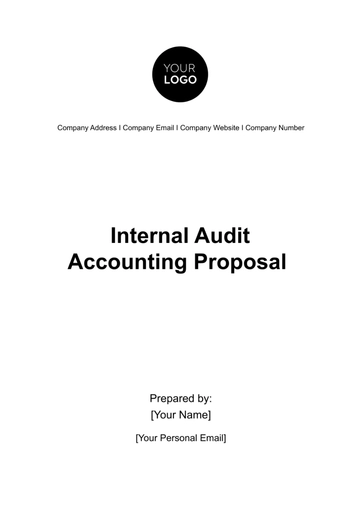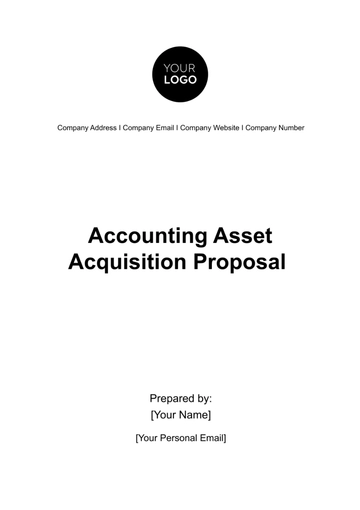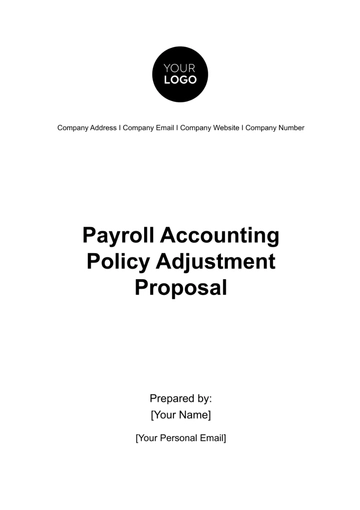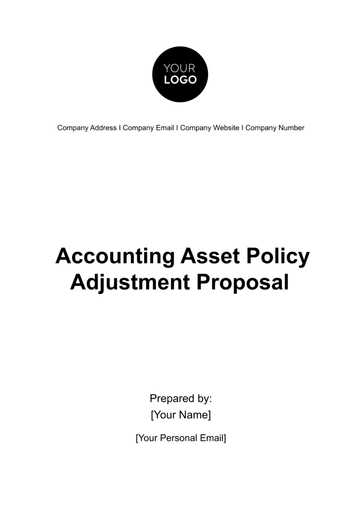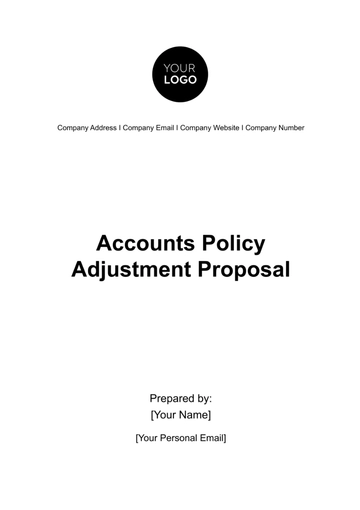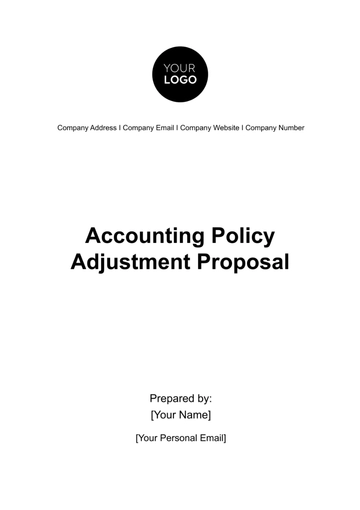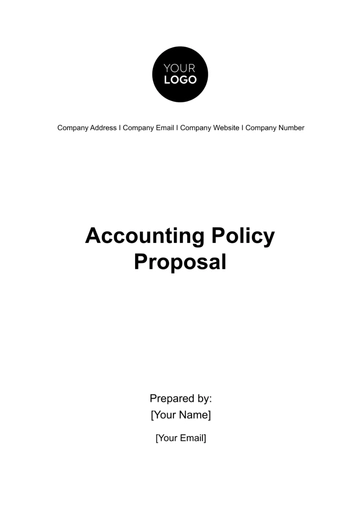Free Accounting Asset Acquisition Proposal
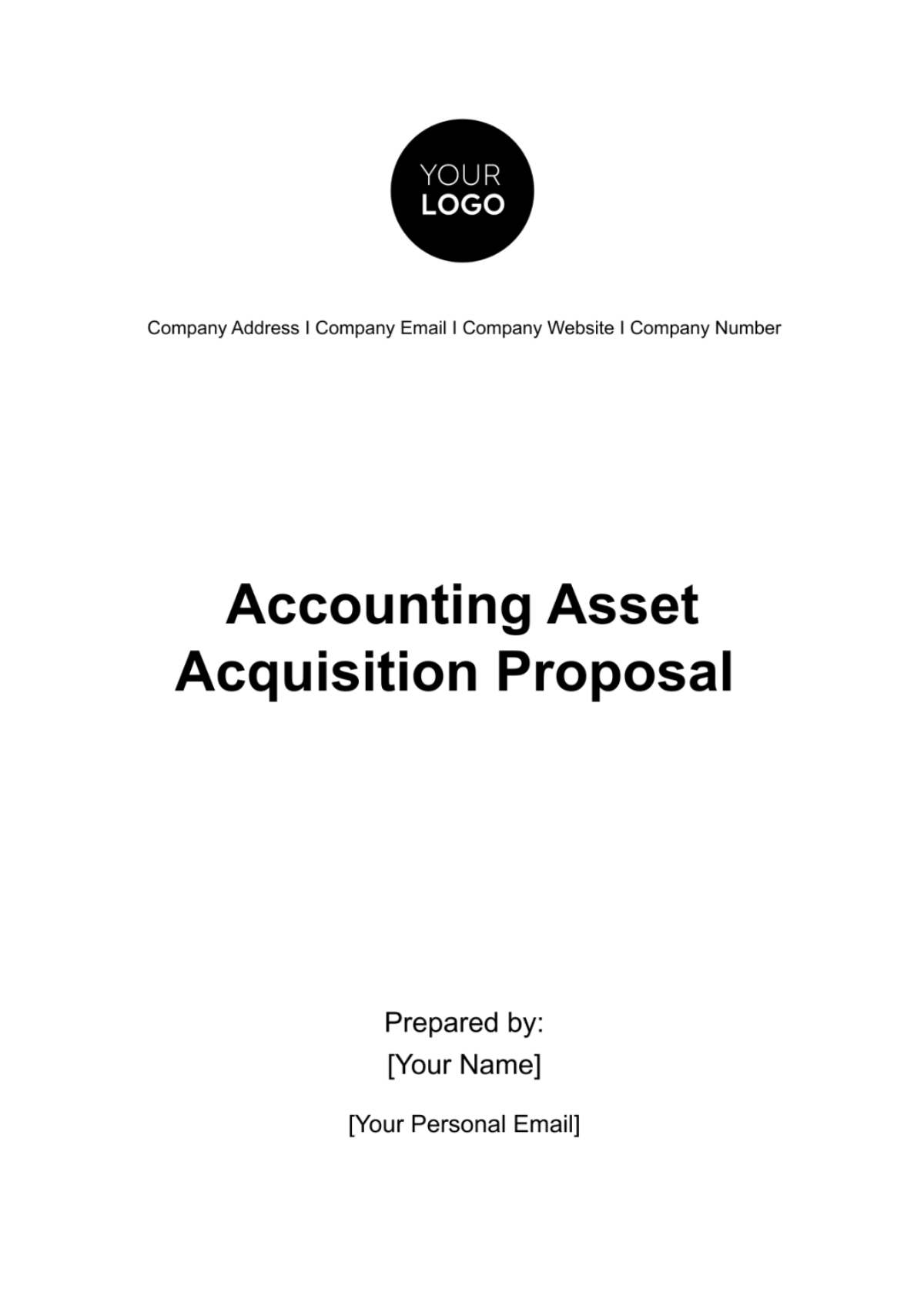
1. Executive Summary
Overview of the Proposal
This proposal presents a strategic plan for [Your Company Name] to acquire a state-of-the-art asset, a move that promises to revolutionize our current operational capabilities. It delves into the specifics of the asset, including its advanced features and technological edge. The proposal meticulously outlines the financial commitment required for this acquisition and illustrates the transformative impact it is expected to have on our business operations, ultimately enhancing our position in the competitive market landscape. This acquisition is not just an expenditure; it is a strategic investment into the future of [Your Company Name], setting a foundation for innovative growth and sustained success.
Objectives and Expected Outcomes
Our primary objective with this acquisition is to catapult [Your Company Name] into a new era of operational efficiency and market leadership. We anticipate that the integration of this asset will lead to a substantial increase in productivity, a significant reduction in operational costs, and an enhanced capacity to meet evolving market demands. This strategic move is poised to open new avenues for revenue generation and provide us with a competitive advantage in our industry. The long-term benefits envisaged from this acquisition align seamlessly with our overarching strategic growth objectives, marking a pivotal step in our journey towards industry leadership.
Financial Implications Summary
The financial aspect of this proposal offers a comprehensive summary of the investment required for the acquisition, including the purchase price, installation costs, and any ancillary expenses. It also outlines the diverse funding options available, ranging from internal reserves to financing solutions, providing a balanced perspective on the financial strategies we can employ. Crucially, the proposal projects a compelling return on investment (ROI), highlighting not only the short-term financial implications but also the long-term financial benefits. This financial analysis is crafted to reassure stakeholders of the proposal's economic soundness and its alignment with [Your Company Name]'s financial goals and risk appetite.
2. Context and Background
In this section, we delve deep into the rationale behind the proposed asset acquisition for [Your Company Name]. It's crucial to understand the context in which this proposal is made – from assessing our current operational capabilities and the limitations of our existing assets to analyzing broader market trends. This comprehensive background forms the bedrock of our strategic decision, ensuring that the proposed acquisition is not just a reaction to immediate needs but a well-thought-out strategy aligned with long-term goals.
A. Current Situation and Need
[Your Company Name] currently faces challenges that hamper our operational efficiency and market responsiveness. An in-depth analysis of our operational processes has revealed bottlenecks and inefficiencies that the new asset is uniquely positioned to address. This acquisition is not merely about adding to our asset base; it's about strategically augmenting our capabilities to meet specific operational challenges. The need for this asset is intricately linked to our strategic goals – it's about future-proofing our operations, enhancing productivity, and staying ahead in a rapidly evolving business landscape.
Operational Challenge | Impact on [Your Company Name] | How New Asset Addresses It |
|---|---|---|
Slow Production Processes | Reduced output, longer lead times | Increases efficiency, reduces cycle time |
High Energy Consumption | Increased operational costs | Energy-efficient technology lowers costs |
Limited Technological Capabilities | Falling behind in innovation | Modern tech enhances product quality and innovation |
Key Insights:
Identified operational bottlenecks are directly impacting productivity and costs.
The new asset offers targeted solutions to these specific challenges.
Strategic alignment with the acquisition ensures meeting future operational demands.
B. Historical Asset Analysis
A thorough review of our existing asset portfolio has shed light on several critical issues. Many of our assets are nearing the end of their useful life, reflected in escalating maintenance costs and frequent downtimes, which have a ripple effect on our productivity and operational costs. The depreciation schedules of these assets indicate a growing need for replacement and modernization. This historical perspective is not just a reflection of past decisions but a beacon guiding us towards more efficient, modern solutions that can propel [Your Company Name] towards future growth.
Asset Category | Average Age (Years) | Annual Maintenance Cost | Downtime Impact (Days/Year) |
|---|---|---|---|
Manufacturing Equipment | 15 | $50,000 | 30 |
IT Infrastructure | 10 | $30,000 | 20 |
Transportation Fleet | 12 | $40,000 | 25 |
Key Insights:
Aging assets are becoming more costly to maintain and operate.
Increased downtime due to older assets impacts overall productivity.
Asset modernization is critical for reducing costs and improving efficiency.
C. Market Trends and Benchmarks
In today's fast-paced market, staying static is not an option. Our analysis of current market trends and industry benchmarks clearly shows a shift towards more advanced, efficient technologies and practices. The proposed asset acquisition aligns perfectly with these trends, positioning [Your Company Name] not just to catch up with competitors but to leapfrog into a position of market leadership. This acquisition is in sync with industry best practices and benchmarks, ensuring that we are not just keeping pace with our competitors but setting new standards in operational excellence.
Trend/Benchmark | Industry Standard | [Your Company Name] Current Status | Expected Benefit from Acquisition |
|---|---|---|---|
Automation and Efficiency | High automation level | Moderate automation | Improved efficiency, reduced labor costs |
Sustainable Practices | Industry-leading eco-friendly standards | Moderate sustainability | Enhanced brand image, compliance with regulations |
Technological Advancement | Rapid adoption of new technologies | Slow technology updates | Increased innovation, staying competitive |
Key Insights:
Current market trends emphasize automation, sustainability, and technological advancement.
[Your Company Name] is currently not meeting these industry benchmarks.
The proposed asset acquisition aligns with these trends, positioning us for future success and market leadership.
3. Description of the Proposed Asset
In this section, we comprehensively describe the proposed asset, highlighting its specifications, the multitude of benefits it offers, and how it perfectly aligns with our operational and strategic objectives. This detailed exposition is designed to provide a clear understanding of the asset's capabilities and its transformative potential for [Your Company Name], ensuring that the decision to acquire it is well-informed and strategically sound.
A. Asset Specifications
The proposed asset, a state-of-the-art manufacturing system, boasts advanced technological features designed for high efficiency and precision. With its cutting-edge automation capabilities, it can significantly streamline production processes. The system is engineered for durability and reliability, with an estimated lifespan of 20 years under optimal operating conditions. It incorporates the latest in AI-driven quality control mechanisms and is adaptable to various production requirements, making it a versatile addition to our operational infrastructure. This asset represents not just an upgrade in equipment but a leap forward in manufacturing technology.
Specification | Detail |
|---|---|
Automation Technology | Advanced robotics and AI-driven systems for precision and efficiency in production processes |
Durability | Engineered for high resilience and a lifespan of 20 years under optimal conditions |
Adaptability | Flexible configuration to meet various production requirements and changes |
Quality Control | Integrated AI-based quality control mechanisms for superior product standards |
Energy Efficiency | Incorporates energy-saving technologies reducing overall operational costs |
Maintenance Requirements | Designed for low maintenance with predictive maintenance capabilities |
Operational Speed | High-speed production capabilities, significantly reducing turnaround times |
B. Benefits and Potential
Acquiring this asset promises a plethora of benefits for [Your Company Name]. Tangibly, it will drastically enhance production efficiency, reduce waste, and lower energy costs, contributing significantly to our sustainability goals. Intangibly, it will position our company at the forefront of technological innovation, improving product quality and enabling the pursuit of new market opportunities. The asset's advanced capabilities will also foster a culture of innovation within the company, enhancing employee skills and engagement in high-tech operational environments.
Benefit/Potential | Impact on [Your Company Name] |
|---|---|
Enhanced Production Efficiency | Increases output, streamlines processes, and minimizes production time |
Waste Reduction | Reduces material waste, contributing to sustainability and cost savings |
Energy Cost Savings | Lower energy consumption leads to significant cost reductions |
Technological Leadership | Positions [Your Company Name] as a leader in adopting cutting-edge technology |
Employee Skill Enhancement | Fosters a skilled workforce adept in high-tech environments |
C. Operational Alignment
The integration of this asset into our current operations is a strategic move aligned with both our immediate and long-term goals. In the short term, it will address existing production bottlenecks, improving output and customer satisfaction. Long-term, it sets the stage for scalable growth, enabling us to adapt swiftly to market changes and customer demands. This asset is not just a tool for the present; it is an investment in the future, aligning perfectly with [Your Company Name]'s vision for innovation and market leadership.
Implementation Area | Strategic Alignment | Expected Outcome |
|---|---|---|
Production Processes | Streamlining and efficiency enhancement | Increased output, reduced lead times |
Quality Control | Implementing AI-driven quality standards | Higher product quality, reduced defects |
Sustainability Goals | Integrating energy-efficient practices | Achieving environmental targets, reducing carbon footprint |
Market Responsiveness | Adapting quickly to changing customer demands and standards | Improved customer satisfaction, increased market share |
Future Growth | Laying the foundation for scalable operations | Long-term business growth and adaptation to market evolution |
4. Financial Analysis and Budgeting
This section of the proposal provides a meticulous financial analysis and budgeting overview for the asset acquisition at [Your Company Name]. It includes a comprehensive cost analysis, explores various funding and financing options, and projects the return on investment. This financial scrutiny is crucial for making informed decisions, ensuring the acquisition is financially viable, and aligning with our company's fiscal strategies and objectives.
A. Cost Analysis
The total cost of acquiring the new manufacturing system is estimated at $2.5 million. This includes the purchase price of $2 million, installation costs of $300,000, and an additional $200,000 for training and integration into our existing operations. These costs encompass all necessary expenditures to bring the asset to a ready-to-use state. Understanding this breakdown is essential for [Your Company Name] to assess the financial implications and to ensure that all aspects of the acquisition are considered in our budgeting.
Cost Component | Amount (USD) | Details |
|---|---|---|
Purchase Price | $2,000,000 | Cost of acquiring the manufacturing system |
Installation Costs | $300,000 | Includes setup, integration, and initial configuration |
Training and Integration | $200,000 | Training for staff and integration with existing systems |
Total Acquisition Cost | $2,500,000 | Comprehensive cost to bring the asset to operational use |
B. Funding and Financing Options
For funding this significant investment, [Your Company Name] is considering a blend of internal and external financing options. We have $1 million available in internal reserves that can be allocated immediately. For the remaining amount, we are exploring a low-interest loan and leasing options. A loan would allow us to spread the cost over time, preserving liquidity, while leasing offers flexibility and potential tax benefits. Each option's impact on our cash flow and financial health has been thoroughly analyzed to select the most beneficial approach.
Funding Source | Amount (USD) | Details |
|---|---|---|
Internal Reserves | $1,000,000 | Allocation from [Your Company Name]'s existing funds |
Low-Interest Loan | $1,000,000 | External financing with favorable interest terms |
Leasing Option | $500,000 | Alternative to outright purchase, with potential tax benefits |
Total Funding | $2,500,000 | Combination of internal and external funding sources |
C. ROI Forecast
The projected ROI for the new manufacturing system is highly favorable. With increased operational efficiency and reduced costs, we expect to save approximately $500,000 annually. Additionally, the asset is expected to enable revenue growth of 10% per year, attributable to increased production capacity and product quality. The payback period is estimated at around five years, after which the asset will continue to contribute positively to our profitability. This forecast is a strong indicator of the asset’s potential to significantly enhance our financial performance.
Financial Aspect | Year 1 | Year 2 | Year 3 | Year 4 | Year 5 |
|---|---|---|---|---|---|
Annual Cost Savings | $500,000 | $500,000 | $500,000 | $500,000 | $500,000 |
Revenue Growth | 10% | 10% | 10% | 10% | 10% |
Cumulative ROI | 20% | 40% | 60% | 80% | 100% |
Payback Period | 5 years |
Note: The ROI forecast anticipates a complete payback within 5 years, with substantial financial benefits continuing post this period.
5. Risk Assessment and Mitigation Strategies
In this critical section, we address the potential risks associated with the acquisition of the new manufacturing system for [Your Company Name]. It's essential to not only identify and analyze these risks but also to develop robust mitigation and contingency strategies. This comprehensive approach ensures that we are prepared to handle any challenges that may arise, safeguarding our investment and maintaining the integrity of our operational workflow.
A. Risk Identification
The acquisition of the new manufacturing system poses several risks. Financially, there's the risk of a substantial capital investment impacting our cash flow. Operationally, the integration of the system could disrupt existing processes, potentially leading to temporary production delays. Additionally, there are market risks, including rapid technological obsolescence and changes in market demand. Identifying these risks is the first step in developing a proactive strategy to manage them effectively.
Risk Category | Risk Description | Potential Impact |
|---|---|---|
Financial Risk | Capital investment strain on cash flow | High initial expenditure impacting liquidity |
Operational Risk | Disruptions during system integration | Temporary reduction in production efficiency |
Market Risk | Technological obsolescence and market shifts | Decreased relevance and competitiveness |
B. Risk Analysis
Upon identifying the risks, a thorough analysis reveals that the financial risk, while significant, is mitigated by our strong financial position and diversified funding approach. The operational disruption risk is moderated by our comprehensive training and integration plan. However, the market risk of technological obsolescence is more challenging, given the fast-paced nature of technological advancements. This analysis helps prioritize risks and focus our mitigation efforts where they are most needed.
Risk Category | Likelihood | Potential Impact | Current Mitigation Status |
|---|---|---|---|
Financial Risk | Moderate | High | Mitigated by diverse funding and strong financial position |
Operational Risk | High | Moderate | Moderated by training and phased integration |
Market Risk | High | High | Challenging due to rapid market and technology changes |
C. Mitigation and Contingency Plans
To mitigate these risks, we have developed several strategies. Financially, we will maintain a contingency fund to manage cash flow effectively. Operationally, we plan phased integration of the system to minimize disruptions and have a dedicated team to manage the transition. To address market risks, we will stay agile, keeping abreast of technological trends and ready to adapt as needed. Our contingency plan includes provisions for rapid response measures in case of unforeseen challenges, ensuring the resilience of our operations.
Risk Category | Mitigation Strategy | Contingency Plan |
|---|---|---|
Financial Risk | Maintain a contingency fund; balanced investment approach | Access additional credit lines if needed |
Operational Risk | Phased system integration; dedicated transition team | Implement temporary operational adjustments |
Market Risk | Continuous market analysis; adapt to technological trends | Innovate and diversify product offerings in response to market shifts |
6. Implementation Plan
In this section, we meticulously map out the implementation plan for the successful acquisition and integration of the new manufacturing system at [Your Company Name]. This plan includes a detailed acquisition timeline, a clear assignment of roles and responsibilities, and a comprehensive outline of the operational changes and training necessary for the seamless integration of the asset. This structured approach ensures a smooth transition, minimizing disruptions and maximizing the benefits of the new system.
A. Acquisition Timeline
The acquisition timeline spans a period of 12 months, starting with the signing of the purchase agreement. Key milestones include the completion of payment within the first month, delivery of the system by the third month, and installation by the sixth month. The following three months will focus on system testing and fine-tuning. By the ninth month, the system will be operational, with the remaining period dedicated to monitoring and optimizing its performance. This timeline is designed to ensure that each phase of the acquisition is executed systematically, aligning with our overall operational goals.
Milestone | Month | Details |
|---|---|---|
Sign Purchase Agreement | Month 1 | Formalize the acquisition deal |
Complete Payment | Month 1 | Finalize the financial transaction |
System Delivery | Month 3 | Receive the new manufacturing system |
Installation | Month 6 | Set up and integrate the system into operations |
Testing and Fine-Tuning | Month 6-9 | Ensure the system functions optimally |
Operational Launch | Month 9 | System goes live and fully operational |
Performance Monitoring | Month 9-12 | Monitor and optimize system performance |
B. Roles and Responsibilities
The success of this acquisition hinges on the effective collaboration of various teams. The procurement team is responsible for negotiating the purchase and overseeing the delivery. The technical team will handle installation and integration, working closely with the operations team to ensure minimal disruption. The finance team will manage the budget and payment schedules. Training and development will oversee staff training, ensuring all employees are proficient in operating the new system. This clear allocation of roles ensures accountability and efficiency throughout the acquisition process.
Team | Role | Responsibilities |
|---|---|---|
Procurement | Acquisition Management | Negotiate purchase, oversee delivery |
Technical | Installation and Integration | Handle setup, ensure system integration with minimal disruption |
Operations | Workflow Management | Coordinate with the technical team for smooth transition |
Finance | Financial Oversight | Manage budget, handle payments |
Training and Development | Employee Training | Implement training programs for staff proficiency |
C. Operational Changes and Training
Integrating the new system will require operational adjustments, particularly in our manufacturing workflows. We plan to phase in the system, gradually shifting production to the new setup. Comprehensive training programs will be rolled out, covering both technical aspects of operating the new system and adjustments in workflow processes. These training sessions will be a mix of on-the-job training and formal workshops, ensuring all staff are confident and capable in utilizing the new system. This approach is critical for harnessing the full potential of the asset and achieving the desired improvements in productivity and efficiency.
Phase | Activity | Details |
|---|---|---|
Phase-in Integration | Gradual System Shift | Slowly transition production to the new system |
Technical Training | Skill Development | Technical aspects of operating the new system |
Workflow Training | Process Adaptation | Adjustments in manufacturing workflows |
On-the-Job Training | Practical Application | Hands-on experience with the new system |
Workshops | Formal Instruction | Structured learning sessions for staff |
7. Conclusion and Recommendations
This final section encapsulates the comprehensive assessment and strategic recommendations of the asset acquisition proposal for [Your Company Name]. It emphasizes the proposal's strengths, the potential impact of the acquisition on our operations, and provides clear guidance on the next steps. This conclusive part is crucial in driving forward the decision-making process, ensuring a well-informed, timely, and effective implementation of the acquisition plan.
A. Final Assessment
The analysis presented in this proposal underscores the significant advantages of acquiring the new manufacturing system for [Your Company Name]. It is evident that this strategic investment will not only enhance our operational efficiency but also position us favorably in the competitive market. The financial analysis, risk assessment, and implementation plan all point towards a clear benefit: this acquisition is a forward-thinking move that aligns with our long-term goals and will catalyze our growth and innovation efforts.
B. Recommendations
Based on the thorough analysis and insights gathered, it is strongly recommended that [Your Company Name] proceeds with the acquisition of the new manufacturing system. The potential benefits far outweigh the risks, which have been effectively mitigated in our planning. This acquisition is more than a capital expenditure; it's a strategic investment in our future, crucial for maintaining our competitive edge and continuing our trajectory of growth and innovation.
C. Next Steps
To initiate this vital acquisition, the immediate next steps involve the approval of the proposal by the executive team, followed by initiating the procurement process. Concurrently, preparations for the operational integration of the system should commence, including setting up the necessary training programs and adjusting production schedules. These steps must be undertaken promptly to capitalize on the benefits and ensure the new system's integration aligns with our operational timelines and objectives.
- 100% Customizable, free editor
- Access 1 Million+ Templates, photo’s & graphics
- Download or share as a template
- Click and replace photos, graphics, text, backgrounds
- Resize, crop, AI write & more
- Access advanced editor
Craft compelling asset acquisition proposals with Template.net's Accounting Asset Acquisition Proposal Template. This template ensures a professional, persuasive presentation. Strengthen your acquisition strategies, making every proposal a testament to your strategic and financial acumen.Make every asset acquisition a milestone of success with this unique asset acquisition proposal template.
You may also like
- Business Proposal
- Research Proposal
- Proposal Request
- Project Proposal
- Grant Proposal
- Photography Proposal
- Job Proposal
- Budget Proposal
- Marketing Proposal
- Branding Proposal
- Advertising Proposal
- Sales Proposal
- Startup Proposal
- Event Proposal
- Creative Proposal
- Restaurant Proposal
- Blank Proposal
- One Page Proposal
- Proposal Report
- IT Proposal
- Non Profit Proposal
- Training Proposal
- Construction Proposal
- School Proposal
- Cleaning Proposal
- Contract Proposal
- HR Proposal
- Travel Agency Proposal
- Small Business Proposal
- Investment Proposal
- Bid Proposal
- Retail Business Proposal
- Sponsorship Proposal
- Academic Proposal
- Partnership Proposal
- Work Proposal
- Agency Proposal
- University Proposal
- Accounting Proposal
- Real Estate Proposal
- Hotel Proposal
- Product Proposal
- Advertising Agency Proposal
- Development Proposal
- Loan Proposal
- Website Proposal
- Nursing Home Proposal
- Financial Proposal
- Salon Proposal
- Freelancer Proposal
- Funding Proposal
- Work from Home Proposal
- Company Proposal
- Consulting Proposal
- Educational Proposal
- Construction Bid Proposal
- Interior Design Proposal
- New Product Proposal
- Sports Proposal
- Corporate Proposal
- Food Proposal
- Property Proposal
- Maintenance Proposal
- Purchase Proposal
- Rental Proposal
- Recruitment Proposal
- Social Media Proposal
- Travel Proposal
- Trip Proposal
- Software Proposal
- Conference Proposal
- Graphic Design Proposal
- Law Firm Proposal
- Medical Proposal
- Music Proposal
- Pricing Proposal
- SEO Proposal
- Strategy Proposal
- Technical Proposal
- Coaching Proposal
- Ecommerce Proposal
- Fundraising Proposal
- Landscaping Proposal
- Charity Proposal
- Contractor Proposal
- Exhibition Proposal
- Art Proposal
- Mobile Proposal
- Equipment Proposal
- Student Proposal
- Engineering Proposal
- Business Proposal
